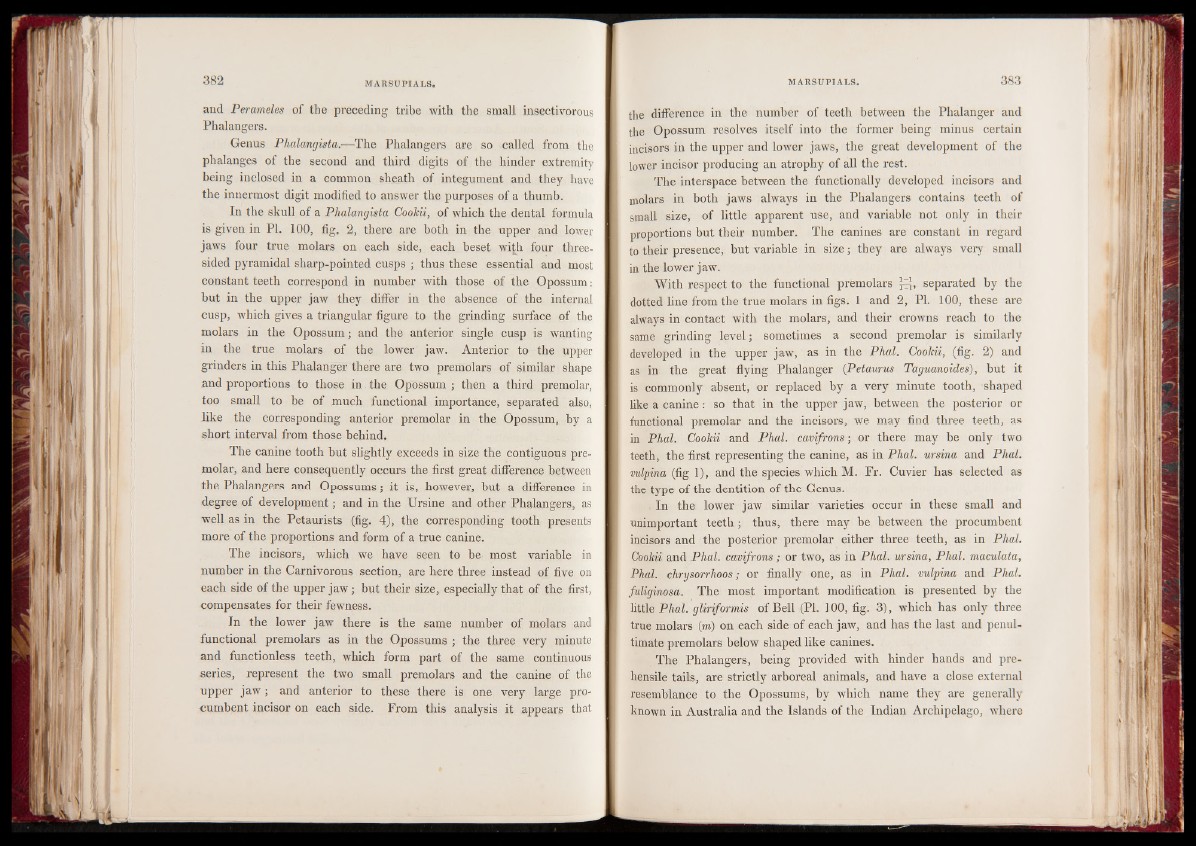
MM
I By, I Hi no I
11 i
i l l
and Perameles of the preceding tribe with the small insectivorous
Phalangers.
Genus Phalangista.—The Phalangers are so called from the
phalanges of the second and third digits of the hinder extremity
being inclosed in a common sheath of integument and they have
the innermost digit modified to answer the purposes of a thumb.
In the skull of a Phalangista Cookii, of which the dental formula
is given in PL 100, fig, 2, there are both in the upper and lower
jaws four true molars on each side, each beset with four three-
sided pyramidal sharp-pointed cusps ; thus these essential and most
constant teeth correspond in number with those of the Opossum:
but in the upper jaw they differ in the absence of the internal
cusp, which gives a triangular figure to the grinding surface of the
molars in the Opossum; and the anterior single cusp is wanting
in the true molars of the lower jaw. Anterior to the upper
grinders in this Phalanger there are two premolars of similar shape
and proportions to those in the Opossum ; then a third premolar,
too small to be of much functional importance, separated also,
like the corresponding anterior premolar in the Opossum, by a
short interval from those behind.
The canine tooth hut slightly exceeds in size the contiguous premolar,
and here consequently occurs the first great difference between
the Phalangers and Opossums; it is, however, hut a difference in
degree of development; and in the Ursine and other Phalangers, as
well as in the Petaurists (fig. 4), the corresponding tooth presents
more of the proportions and form of a true canine.
The incisors, which we have seen to be most variable in
number in the Carnivorous section, are here three instead of five on
each side of the upper jaw; but their size, especially that of the first,
compensates for their fewness.
In the lower jaw there is the same number of molars and
functional premolars as in the Opossums ; the three very minute
and functionless teeth, which form part of the same continuous
series, represent the two small premolars and the canine of the
upper jaw ; and anterior to these there is one very large procumbent
incisor on each side. From this analysis it appears that
the difference in the number of teeth between the Phalanger and
the Opossum resolves itself into the former being minus certain
incisors in the upper and lower jaws, the great development of the
lower incisor producing an atrophy of all the rest.
The interspace between the functionally developed incisors and
molars in both jaws always in the Phalangers contains teeth of
small size, of little apparent use, and variable not only in their
proportions but their number. The canines are constant in regard
to their presence, but variable in size; they are always very small
in the lower jaw.
With respect to the functional premolars separated by the
dotted line from the true molars in figs. 1 and 2, PL 100, these are
always in contact with the molars, and their crowns reach to the
same grinding level; sometimes a second premolar is similarly
developed in the upper jaw, as in the Phal. Cookii, (fig. 2) and
as in the great flying Phalanger (Petaurus Taguanoides), but it
is commonly absent, or replaced by a very minute tooth, shaped
like a canine: so that in the upper jaw, between the posterior or
functional premolar and the incisors, we may find three teeth, as
in Phal. Cookii and Phal. cavifrons; or there may he only two
teeth, the first representing the canine, as in Phal. ursina and Phal.
vulpina (fig 1), and the species which M. Fr. Cuvier has selected as
the type of the dentition of the Genus.
, In the lower jaw similar varieties occur in these small and
unimportant teeth ; thus, there may he between the procumbent
incisors and the posterior premolar either three teeth, as in Phal.
Cookii and Phal. cavifrons; or two, as in Phal. ursina, Phal. maculata,
Phal. chrysorrhoos; or finally one, as in Phal. vulpina and Phal.
fuliginosa. The most important modification is presented by the
little Phal. gliriformis of Bell (Pl. 100, fig. 3), which has only three
true molars (m) on each side of each jaw, and has the last and penultimate
premolars below shaped like canines.
The Phalangers, being provided with hinder hands and prehensile
tails, are strictly arboreal animals, and have a close external
resemblance to the Opossums, by which name they are generally
known in Australia and the Islands of the Indian Archipelago, where
>
III s